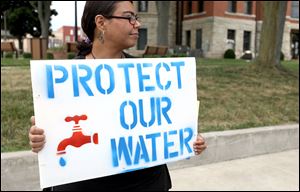
Montpelier to hear aquifer proposal
8/26/2018
Protesters hold signs during a protest next to the Williams County Courthouse in Bryan, Ohio.
THE BLADE
Buy This Image
MONTPELIER, Ohio — Pioneer Mayor Ed Kidston — whose company, Artesian of Pioneer, has been vilified by local residents for devising a plan to sell Michindoh Aquifer water to at least three Toledo-area suburbs — told The Blade he plans to address Williams County residents at the Montpelier village council meeting at 6 p.m. Monday, during which time he will introduce the hydrogeologist he has retained as his chief consultant for the project.
A state official confirmed the project — if it comes to fruition — would be a first for Ohio.
Mr. Kidston said his presentation will last 30 minutes, and there will be a 30-minute question-and-answer period with councilmen after that. It is unclear if there will be time for a Q & A with the public, he said.
The meeting is expected to be preceded by a protest starting at 5 p.m. The meeting has been moved to the village’s fire station on Monroe Street to accommodate a large crowd.
RELATED CONTENT: Bryan residents say aquifer proposal is all wet ■ Hundreds protest aquifer plan ■ Suburbs see future in water from aquifer

Norah Gonzalez, of Bryan, Ohio, holds up a sign for passing cars and pedestrians to see during a protest next to the Williams County Courthouse in Bryan, Ohio, on Sunday, July 29, 2018.
About 200 people protested at Pioneer’s Aug. 13 council meeting, many of them upset that board members would not vote on a resolution to kill the project. The same resolution is expected to come up at the Montpelier meeting.
Mr. Kidston told The Blade he remains committed to the project. His expectation is that test wells will be drilled in September, and that preliminary results will be ready before Christmas. He promises to share those with the public.
If all goes as planned, he said, water could be ready for Toledo-area suburbs and portions of Henry and Fulton counties in as few as two years but certainly by 2026, when several contracts with the city of Toledo expire.
He believes data will show Williams County has enough water and rain to keep the project sustainable for decades.
“We're not really taking any water that's not already leaving the area,” Mr. Kidston said. “I think once people are able to grasp that, then all of this hoopla and hype will quiet down some.”
He said he’s not dismayed by protesters.
“There are always people out there trying to scare the heck out of everybody with falsehoods and scare tactics,” he said.
Many of those who oppose his project, though — including several Bryan city officials — remain outraged and betrayed by the thought that Mr. Kidston could send local water to the Toledo area.
Josh Nichols, a 37-year-old Montpelier resident organizing most of the protests, has said he finds Mr. Kidston’s project offensive and a conflict of interest. He said he’s glad it came out before a permit application was filed so he and members of the Williams County Alliance could get a jump on mobilizing.
“I really urge people to get involved,” Mr. Nichols said. “I think community pressure is the only thing that gets to him.”
State officials said no permit applications have been filed. Nor do they have a record of Mr. Kidston contacting the Ohio Environmental Protection Agency, the Ohio Department of Natural Resources, or Gov. John Kasich’s office.
“You haven't heard anything from the Kasich administration yet because it hasn't received anything,” Heidi Griesmer, Ohio EPA deputy director of communications, said.
The governor’s press secretary, Jon Keeling, said he had no comment beyond what the Ohio EPA and the Ohio DNR told The Blade.
Spokesmen for both agencies laid out a long list of permit obligations Mr. Kidston would have to meet to do the project, including a general plan that would look at options available, costs, and information about construction, operation, and maintenance.
Stephanie Leis, Ohio DNR spokesman, said Artesian of Pioneer must first register a request with that agency’s Division of Water Resources for a water withdrawal from the Michindoh Aquifer. The registration itself is not a permit, she said.
Written commitments would be required from each community asking to receive water, Ms. Griesmer said.
The Ohio EPA also would require corrosion control studies. A lack of corrosion control was largely the reason lead leached from Flint’s aging pipes, causing that city’s high-profile water crisis.
Wells must be sited. The water system must have both control and ownership of the land where the wells are located, Ms. Griesmer said.
Owners also must develop a source water protection area plan and protect that source. Wells must be constructed in accordance with standards. And operators must get a withdrawal permit from the Ohio DNR.
Artesian of Pioneer would have to demonstrate that its new water system would work. It would need to submit an asset management plan to show how it plans to maintain its equipment. A new law pertaining to those plans becomes effective Oct. 1, Ms. Griesmer said.
The company also would need a detailed plan for design of the wells, the water treatment plant and related infrastructure, as well as a license to operate a water plant, she said.
Wetlands permits also would likely be required if any pipeline crosses marshy areas or waterways, she said.
When asked if any other company has attempted to pump aquifer water to other communities already served by another source, Ms. Griesmer replied: “This would be a first.”
Because the aquifer is within the Great Lakes basin, withdrawals are subject to provisions of the Great Lakes-St. Lawrence River Basin Water Resources Compact that went into effect 10 years ago.
Though written primarily to ward off large transfers of water to the Sun Belt or other parched regions of the world, the compact also places limits on how much water can be moved within the Great Lakes basin.
The act was approved by Congress, signed into law by former President George W. Bush, and implemented by legislatures in each of the eight Great Lakes states.
Peter Johnson is deputy director of Great Lakes St. Lawrence Governors & Premiers, formerly the Council of Great Lakes Governors. The government agency acts as secretariat for the compact council.
He declined to talk about the specifics of this case, but said individual states bear most of the responsibility for ensuring withdrawals are consistent with the compact.
In Ohio, that means a special permit for withdrawals of 1 million gallons a day averaged over a 90-day period. Mr. Kidston said he expects to have Artesian of Pioneer withdraw 10 million to 14 million gallons a day.
Legal scholars such as Ken Kilbert, a University of Toledo law professor who specializes in water issues, said it’s hard to say now if compact rules could complicate or even threaten the project.
“Nobody thinks about water until they have to think about water,” he said.
Jim Olson, a Traverse City water-rights lawyer who has helped a citizens group in its fight against Nestle Corp.’s massive withdrawals from a west Michigan aquifer, said courts over the past 10 years “have found a single hydrological connection between groundwater and lakes, streams, and wetlands, and thereby limit massive proposed water withdrawals or existing ones, as a violation of the public trust doctrine in water.”
Rights of citizens as beneficiaries are protected by that doctrine, because of potential impacts to rivers, streams, wildlife, and the environment, he said.
The project has caught the attention of people in Michigan and Indiana, too.
Dave Schulenberg, Michigan Ground Water Association executive director, and Jennifer Alexander, Indiana Ground Water Association executive director, said they are monitoring the situation but don’t have enough information to weigh in yet.
Mr. Kidston said he expects Toledo-area suburbs to become part of the Henry County Regional Water & Sewer District based in Napoleon.
“That district will sign a contract with us to do an investigation,” he said.
He said he expects the report from that investigation “will prove water's there and will not interfere with any other customer.”
“Right now, the plan is to do everything in Ohio,” Mr. Kidston said.
Contact Tom Henry at: thenry@theblade.com, 419-724-6079, or via Twitter @ecowriterohio.